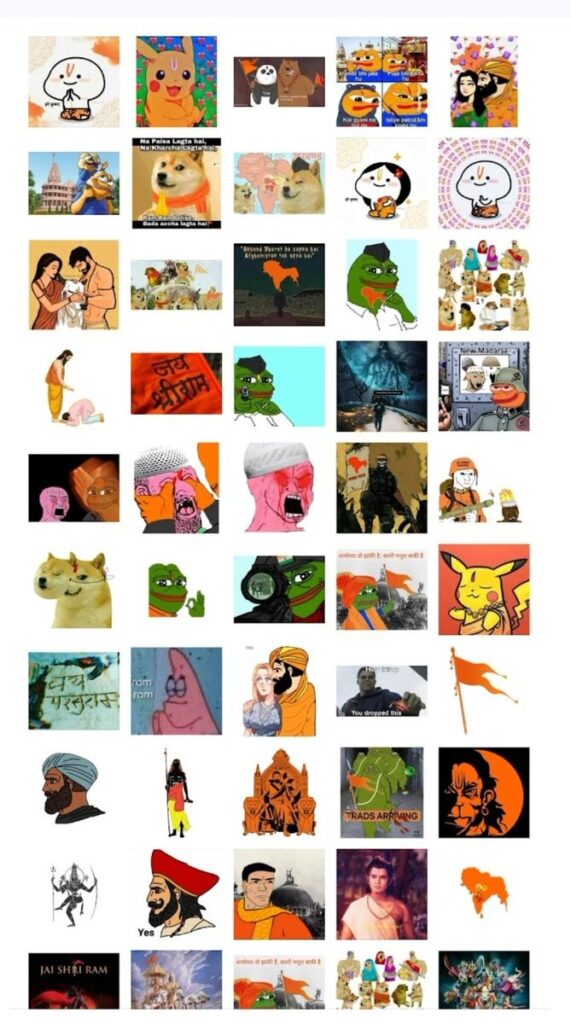
Social media platform Telegram is fast becoming the brewing ground for Hindutva propaganda in the form of memes, images, and fake news.
An article by The Wire discusses how Telegram has been used constantly and extensively by Hindutva supporters as compared to other platforms such as X, Meta (formerly Facebook), Whatsapp and others.
In a historic ceremony on January 22, Prime Minister Narendra Modi inaugurated the long-awaited Ram Temple in Ayodhya, a site steeped in controversy since the demolition of the 16th-century Babri Masjid in 1992, which was led by senior BJP leaders such as LK Advani, Uma Bharati, and the late Prime Minister Atal Bihari Vajpayee.
As PM Modi spoke about how the temple ‘is a symbol of peace, harmony, and integration for all Indians’, the Telegram Hindutva groups unleashed a flood of hate messages, fake news, trades, raitas, memes and open calls for violence against the Muslim community.
One such message in a channel called Samaj, with around 700 subscribers, says, “Tbh ab mullo ka future h nhi india me. kuch tym baad khule nhi dikhenge ye (To be honest there is no future of Muslims in India. They will not be seen in the open after some time.)”
How does Telegram function?
The Chair Professor of Communication at Massey University, New Zealand, Professor Mohan J Dutta studies the online Hindutva hate ecosystem. “Telegram functions as a broadcasting channel, allowing for the rapid spread of messages to a large audience, including calls to violence and the organisation of people,” he was quoted by The Wire.
Hence, unlike other social media platforms such as X (formerly Twitter), Meta etc., Telegram works like a broadcaster, in simple words, like a TV or a radio. So when a message is broadcast, it quickly spreads like wildfire to a large number of members attached to similar groups or channels, playing a significant role in shaping debates and pushing propaganda.
The hate propaganda can be against any community (here in India it is against minorities). Moreover, if one is a member of a certain group, Telegram suggests other similar groups, thus making the circulation more widespread, like an epidemic.
Telegram Hindutva stickers
Telegram offers stickers, with the Hindutva supporters mainly preferring ‘Pepe the frog’. It is often referred to as a trad or raita, representing far-right supporters in India.
‘Pepe the frog’ has been moulded by Hindutva groups to tune into their right-wing fantasy. The saffron frog dressed up in a Nazi-like uniform with Om symbols represents Hindutva or saviours of the Hindu religion, while Muslims are mostly represented as brown people with beards and skull caps. Then there is the blue frog which mocks “Bhimtas” (a slur for Dalit Ambedkarites).
Propaganda images of disturbing scenarios, such as Muslims locked inside a jail with ‘New Madarsa’ written on it and saffron ‘Pepe the frog’ ready to press a green button, locking them up in a concentration camp, similar to Hitler’s Germany during World War II.
Telegram is also used to spread vile, sexual violence, toxic masculinity, and misogynist comments against Muslim women, an open call for rape or calling them a ‘child-bearing machine’.

Telegram’s safety policy
According to Telegram’s safety policy, everything is stored in encrypted format. “The encryption keys protecting the data are split apart and never kept with the data they protect. Encryption is critical to ensuring private data remains private.”
In addition, Telegram states on Public Chats that “Telegram also supports public channels and public groups. All public chats are cloud chats. Cloud chats are messages, photos, videos and documents which are stored on our servers so that you can access your data from any of your devices anytime without having to rely on third-party backups. Like everything on Telegram, the data you post in public communities is encrypted, both in storage and in transit — but everything you post in public will be accessible to everyone.”
A Telegram user can report a particular post/message in the following categories: spam, violence, child abuse, illegal drugs, personal details, and pornography. However, there is no mention of hate speech or dehumanisation.
Though the platform offers ‘Others’, where one can manually enter their complaint, it does not offer any option to select the relevant problematic post – the report needs to be against the channel in general, The Wire reports.
However, Professor Dutta believes that since the exposure is broader on X or Meta due to its public platform status, Telegram provides a comfortable ecosystem to spread hate.
“Telegram is primarily a dissemination channel and doesn’t really provide a feedback mechanism in that way. Therefore, content moderation is much weaker on Telegram,” he says.



